Outsider art
Outsider art is art by self-taught or naïve art makers. Typically, those labeled as outsider artists have little or no contact with the mainstream art world or art institutions. In many cases, their work is discovered only after their deaths. Often, outsider art illustrates extreme mental states, unconventional ideas, or elaborate fantasy worlds.

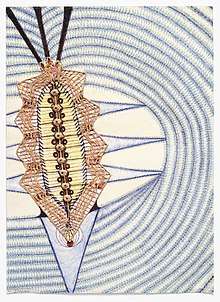
The term outsider art was coined by art critic Roger Cardinal in 1972 as an English synonym for art brut (French: [aʁ bʁyt], "raw art" or "rough art"), a label created by French artist Jean Dubuffet to describe art created outside the boundaries of official culture; Dubuffet focused particularly on art by those on the outside of the established art scene, using as examples psychiatric hospital patients and children.[1][2]
Outsider art has emerged as a successful art marketing category; an annual Outsider Art Fair[3] has taken place in New York since 1993, and there are at least two regularly published journals dedicated to the subject. The term is sometimes misapplied as a catch-all marketing label for art created by people who are outside the mainstream "art world" or "art gallery system", regardless of their circumstances or the content of their work.[4] A more specific term, "outsider music", was later adapted for musicians.
Art of the mentally ill
Interest in the art of the mentally ill, along with that of children and the makers of "peasant art", was first demonstrated by "Der Blaue Reiter" group: Wassily Kandinsky, Auguste Macke, Franz Marc, Alexej Jawlensky, and others. What the artists perceived in the work of these groups was an expressive power born of their perceived lack of sophistication. Examples of this were reproduced in 1912 in the first and only issue of their publication, Der Blaue Reiter Almanac. During World War I, Macke was killed at Champagne in 1914 and Marc was killed at Verdun in 1916; the gap left by these deaths was to some extent filled by Paul Klee, who continued to draw inspiration from these 'primitives'.
Interest in the art of insane asylum inmates continued to grow in the 1920s. In 1921, Dr. Walter Morgenthaler published his book Ein Geisteskranker als Künstler (A Psychiatric Patient as Artist) about Adolf Wölfli, a psychotic mental patient in his care. Wölfli had spontaneously taken up drawing, and this activity seemed to calm him. His most outstanding work was an illustrated epic of 45 volumes in which he narrated his own imaginary life story. With 25,000 pages, 1,600 illustrations, and 1,500 collages, it is a monumental work. Wölfli also produced a large number of smaller works, some of which were sold or given as gifts. His work is on display at the Adolf Wölfli Foundation in the Museum of Fine Art, Bern.
A defining moment was the publication of Bildnerei der Geisteskranken (Artistry of the Mentally Ill) in 1922, by Hans Prinzhorn. This was the first formal study of psychiatric works, based upon a compilation of thousands of examples from European institutions. The book and the art collection gained much attention from avant-garde artists of the time, including Paul Klee, Max Ernst, and Jean Dubuffet.[5]
People with some formal artistic training as well as well-established artists are not immune from mental illness, and may also be institutionalized. For example, William Kurelek, later awarded the Order of Canada for his artistic life work, as a young man was admitted to the Maudsley Psychiatric Hospital where he was treated for schizophrenia.[6] In hospital he painted, producing The Maze, a dark depiction of his tortured youth.[7] He was transferred from the Maudsley to Netherne Hospital from November 1953 to January 1955, to work with Edward Adamson (1911–1996), a pioneer of art therapy, and creator of the Adamson Collection.
Jean Dubuffet and art brut
French artist Jean Dubuffet was particularly struck by Bildnerei der Geisteskranken and began his own collection of such art, which he called art brut or raw art. In 1948 he formed the Compagnie de l'Art Brut along with other artists, including André Breton. The collection he established became known as the Collection de l'art brut. It contains thousands of works and is now permanently housed in Lausanne, Switzerland.
Dubuffet characterized art brut as:
- "Those works created from solitude and from pure and authentic creative impulses – where the worries of competition, acclaim and social promotion do not interfere – are, because of these very facts, more precious than the productions of professionals. After a certain familiarity with these flourishings of an exalted feverishness, lived so fully and so intensely by their authors, we cannot avoid the feeling that in relation to these works, cultural art in its entirety appears to be the game of a futile society, a fallacious parade." — Jean Dubuffet. Place à l'incivisme (Make way for Incivism). Art and Text no.27 (December 1987 – February 1988). p.36 Dubuffet's writing on art brut was the subject of a noted program at the Art Club of Chicago in the early 1950s.
Dubuffet argued that 'culture', that is mainstream culture, managed to assimilate every new development in art, and by doing so took away whatever power it might have had. The result was to asphyxiate genuine expression. Art brut was his solution to this problem – only art brut was immune to the influences of culture, immune to being absorbed and assimilated, because the artists themselves were not willing or able to be assimilated.
Cultural context
The interest in "outsider" practices among twentieth-century artists and critics can be seen as part of a larger emphasis on the rejection of established values within the modernist art milieu. The early part of the 20th century gave rise to Cubism and the Dada, Constructivist and Futurist movements in art, all of which involved a dramatic movement away from cultural forms of the past. Dadaist Marcel Duchamp, for example, abandoned "painterly" technique to allow chance operations a role in determining the form of his works, or simply to re-contextualize existing "readymade" objects as art. Mid-century artists, including Pablo Picasso, looked outside the traditions of high culture for inspiration, drawing from the artifacts of "primitive" societies, the unschooled artwork of children, and vulgar advertising graphics. Dubuffet's championing of the art brut – of the insane and others at the margins of society – is yet another example of avant-garde art challenging established cultural values.
Terminology
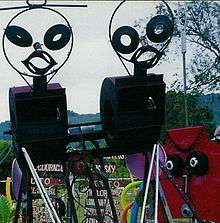
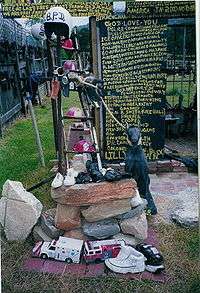
A number of terms are used to describe art that is loosely understood as "outside" of official culture. Definitions of these terms vary and overlap.[8] The editors of Raw Vision, a leading journal in the field, suggest that "Whatever views we have about the value of controversy itself, it is important to sustain creative discussion by way of an agreed vocabulary". Consequently, they lament the use of "outsider artist" to refer to almost any untrained artist. "It is not enough to be untrained, clumsy or naïve. Outsider Art is virtually synonymous with Art Brut in both spirit and meaning, to that rarity of art produced by those who do not know its name."
- Art Brut: literally translated from French means "raw art"; 'Raw' in that it has not been through the 'cooking' process: the world of art schools, galleries, museums. Originally art by psychotic individuals who existed almost completely outside culture and society. Strictly speaking it refers only to the Collection de l'art brut.
- Folk art: Folk art originally suggested crafts and decorative skills associated with peasant communities in Europe – though presumably it could equally apply to any indigenous culture. It has broadened to include any product of practical craftsmanship and decorative skill – everything from chain-saw animals to hub-cap buildings. A key distinction between folk and outsider art is that folk art typically embodies traditional forms and social values, where outsider art stands in some marginal relationship to society's mainstream.
- Intuitive art/Visionary art: Raw Vision Magazine's preferred general terms for outsider art. It describes them as deliberate umbrella terms. However, Visionary Art unlike other definitions here can often refer to the subject matter of the works, which includes images of a spiritual or religious nature. Intuitive art is probably the most general term available. Intuit: The Center for Intuitive and Outsider Art based in Chicago operates a museum dedicated to the study and exhibition of intuitive and outsider art. The American Visionary Art Museum in Baltimore, Maryland is dedicated to the collection and display of visionary art.
- Marginal art/Art singulier: Essentially the same as Neuve Invention; refers to artists on the margins of the art world.
- Naïve art: Another term commonly applied to untrained artists who aspire to "normal" artistic status, i.e. they have a much more conscious interaction with the mainstream art world than do outsider artists.
- Neuve invention: Used to describe artists who, although marginal, have some interaction with mainstream culture. They may be doing art part-time for instance. The expression was coined by Dubuffet too; strictly speaking it refers only to a special part of the Collection de l'art brut.
- Visionary environments: Buildings and sculpture parks built by visionary artists – range from decorated houses, to large areas incorporating a large number of individual sculptures with a tightly associated theme. Examples include Watts Towers by Simon Rodia, Buddha Park and Sala Keoku by Bunleua Sulilat, and The Palais Ideal by Ferdinand Cheval.
Notable outsider artists
- Nick Blinko (born 1961) is an English musician and artist diagnosed with schizoaffective disorder. He is represented in the Collection de l'art brut in Lausanne. He is best known through his works with his band Rudimentary Peni.
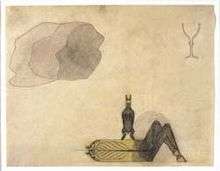
- Sid Boyum[9] (1914–1991) was an industrial photographer who turned his home and yard into a vast, dense array of concrete and wood sculptures, many of which have since been moved to public locations[10] throughout his neighborhood in Madison, Wisconsin.
- Al Carbee (1914–2005) was a prolific, multi-format artist who is known for his Barbie collages. Carbee created a massive imaginary utopia with his collages, which he called "Epicuma". When Carbee was in his 80s, his art was discovered accidentally by filmmaker Jeremy Workman, leading to a flurry of interest in his later years.[11] Carbee was the subject of Workman's documentary film Magical Universe.
- Benny Carter (1943–2014) was an American artist known for his paintings of New York City and rural North Carolina.
- James Charles Castle (1899-1977) was a self-taught artist from Garden Valley, Idaho.
- Nek Chand (1924–2015) was an Indian artist, famous for building the Rock Garden of Chandigarh, a forty-acre (160,000 m2) sculpture garden in the city of Chandigarh, India.
- Ferdinand Cheval (1836–1924) was a country postman in Hauterives, south of Lyon, France. Motivated by a dream, he spent 33 years constructing the Palais Ideal. Half organic building, half massive sculpture, it was constructed from stones collected on his postal round, held together with chicken wire, cement, and lime.
- Felipe Jesus Consalvos (1891–c. 1960) was a Cuban-American cigar roller and artist, known for his posthumously discovered body of art work based on the vernacular tradition of cigar band collage.
- Richard Dadd (1817–1886), noted for his depictions of fairies and other supernatural subjects, rendered with obsessively minuscule detail. Most of the works for which he is best known were created while he was a patient in Bethlem and Broadmoor psychiatric hospitals.
- Henry Darger (1892–1973) was a solitary man who was orphaned and institutionalized as a child. In the privacy of his small north side Chicago apartment, he produced over 35,000 pages of text and hundreds of large scale illustrations, including maps, collaged photos, and watercolors that depict the heroic struggles of his child characters, "the Vivian Girls", engaged in activities such as battle scenes combining imagery of the US Civil War with the presence of fanciful monsters.
- Terry A. Davis (1969-2018), a schizophrenic computer programmer and creator of TempleOS.
- Charles Dellschau (1830–1923) born in Prussia, Dellschau emigrated to the US and in his 70s secluded himself in an attic and over the course of 20 years created 12 large scale books filled with mixed media watercolors depicting the inventions of the Sonora Aero Club, chronicling the birth of the age of aviation. It is unknown if his subject was factual, a fictionalization or a delusion.
- Holly Farrell, 21st century Canadian self taught artist whose paintings include the Barbie & Ken series, is considered an Outsider artist.[12]
- Madge Gill (1882–1961) was an English mediumistic artist who made thousands of drawings "guided" by a spirit she called "Myrninerest" (my inner rest).
- Paul Gösch (1885–1940), a schizophrenic German artist and architect murdered by the Nazis in their euthanasia campaign.
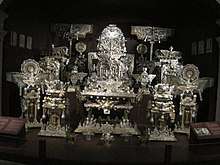
- James Hampton (1909–1964) was an African-American janitor who secretly built a large assemblage of religious art from scavenged materials, such as discarded light bulbs and aluminum foil[13]
- Annie Hooper (1897–1986), a sculptor of visionary religious art from Buxton, North Carolina, who created nearly 5,000 sculptures depicting biblical scenes. Her work is now in the permanent collection of North Carolina State University.
- Georgiana Houghton (1814–1884), a British spiritualist medium, known for her visionary 'spirit drawings', consisting of intricate abstract watercolours.
- Vojislav Jakic (1932–2003), a Serbian artist who spent most of his life in a small town of Despotovac producing drawings up to five meters long evoking the memories of his own life, his obsessions with death, and reflections on art. His works mix abstraction and graphic signs and writings.
- Mollie Jenson (1890–1973) created a series of large-scale concrete sculptures embellished with tile mosaics in River Falls, Wisconsin.
- Daniel Johnston (1961-2019) a lo-fi musician with schizophrenia known for his "childlike" music.
- Susan Te Kahurangi King (born 1951) is a New Zealand artist whose ability to speak declined by the age of four and stopped speaking altogether by age eight. King is an autistic savant who has methodically created an entire analogous world through extraordinary drawings using pen, graphite, colored pencil, crayon and ink. She drew prolifically through to the early 1990s and then without reason suddenly stopped. King renewed drawing in 2008 during filming of a documentary on her artwork.
- Leonard Knight (1931–2014) created the Salvation Mountain, a covered hill art installation in the Colorado Desert that encompasses numerous murals and areas painted with Christian sayings and Bible verses.
- George Paul Kornegay (1913–2014) created a large Christian visionary environment from found objects on a hill near his home in Brent, Alabama.[14]
- Norbert Kox (born 1945), formerly a hard-drinking and drugging member of the Outlaws biker gang, Norbert Kox began to produce a highly singular style of iconography sometime after his conversion to Christianity, and a long period of hermitage and study.
- Paul Laffoley (1940–2015) an American artist, Laffoley's pieces are painted on large canvases and combine words and imagery to depict a spiritual architecture of explanation, tackling concepts like dimensionality, time travel through hacking relativity, connecting conceptual threads shared by philosophers through the millennia, and theories about the cosmic origins of mankind.
- Maud Lewis (1903–1970) was a Canadian folk artist. Lewis painted bright scenes of rural Nova Scotian life on found objects, including boards, construction materials, etc.
- Alexander Lobanov (1924–2003) was a withdrawn deaf Russian known for detailed and self-aggrandizing self-portraits: paintings, photographs and quilts, which usually include images of large guns.
- Justo Gallego Martínez (born 1925) is a Spanish former monk who has been erecting a cathedral-like building in the town of Mejorada del Campo, Spain, since 1961. The building has neither any planning permissions, nor has it the benediction of any church authority.
- Helen Martins (1897–1976) transformed the house she inherited from her parents in Nieu-Bethesda, South Africa, into a fantastical environment decorated with crushed glass and cement sculptures. The house is known as The Owl House.
- Tarcisio Merati (1934–1995), an Italian artist, was confined to a psychiatric hospital for most of his adult life during which time he produced a vast amount of drawings (several dream toys, bird on nest etc.), text and musical composition.
- Markus Meurer (born 1959), a German artist, transforms found objects into mythic creations, hybrid creatures of animal, man and machine.
- Ataa Oko (1919–2012), a Ghanaian artist who was one of the first builders of fantasy coffins and who became in collaboration with a social anthropologist, Regula Tschumi, a painter at the age of 85. He started to draw and paint his former fantasy coffins, but also religious ceremonies and spirits he pretended to see.
- The Philadelphia Wireman, a creator of wire sculptures. Nothing is known of their identity and they are presumed deceased.
- Martín Ramírez (1895–1963), a Mexican outsider artist who spent most of his adult life institutionalized in a California mental hospital (he had been diagnosed as paranoid schizophrenic). He developed an elaborate iconography featuring repeating shapes mixed with images of trains and Mexican folk figures.
- Achilles Rizzoli (1896–1981) was employed as an architectural draftsman. He lived with his mother near San Francisco, California. After his death, a huge collection of elaborate drawings were discovered, many in the form of maps and architectural renderings that described a highly personal fantasy exposition, including portraits of his mother as a neo-baroque building.
- Royal Robertson (1936–1997), a schizophrenic sign painter who received vivid, violent visions of spaceships, God, and the apocalypse, which he then translated into bright, colourful, comic-book like sketches, often including references to his wife's unfaithfulness.
- Sam (Simon) Rodia (1875–1965) was an itinerant construction worker and untrained in the arts. Plagued by personal problems, he abandoned his family to ride the rails until he settled in Los Angeles and created the landmark Watts Towers. Abandoning his monumental life's work, he returned to die with his family, among whom he was regarded as a bum, artist, crazy or a genius.
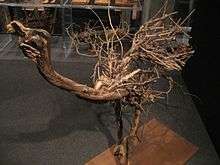
- Eugenio Santoro (1920–2006) was an Italian sculptor and painter. He moved to Switzerland working as a laborer, then he began a brilliant career as a wood sculptor, carving life-size human and animals figures of great expressiveness from fruit trees, which he sometimes painted and coated with varnish.
- John Schacht (1938–2009) was a pre-Stonewall-generation gay artist from the American Midwest who created biomorphic, psychedelic-like abstract paintings, semi-representational erotic drawings and ritual-like altars and assemblages.[15][16][17]
- Friedrich Schröder Sonnenstern (1892–1982) was a German painter who achieved fame and notoriety in the 1950s and 60s for his scabrous, often erotic works.
- Judith Scott (1943–2005) was born deaf and with Down syndrome. After being institutionalized for 35 years she attended Creative Growth Art Center (a center for artists with disabilities in Oakland, California) and went on to become an internationally renowned fiber art sculptor.
- Richard Sharpe Shaver (1907–1975) produced photographs, paintings, drawings and writing connected to his unorthodox theories about the history of life on Earth. He believed that certain stones were actually image-filled "rock books" created by an ancient superior race, and that sadistic descendants of those ancients live inside the earth, using ancient "ray" machines to torment humankind. His paintings, based on rock slices, often incorporate unusual materials such as soap flakes.
- Charles Steffen (1927–1995), Chicago artist, made art while institutionalized.
- Kea Tawana (born c. 1935), American sculptor who created the Ark, an 86-foot-long ship made from architectural salvage in a vacant lot in Newark, New Jersey.
- Miroslav Tichý (1926–2011) was a photographer who took thousands of surreptitious pictures of women in his hometown of Kyjov in the Czech Republic, using homemade cameras constructed of cardboard tubes, tin cans and other at-hand materials.
- Martin Thompson (born 1956) New Zealand artist self-diagnosed with Asperger syndrome. A mathematical savant, he hand draws obsessive fractal patterns on grid paper using art pens.
- Harry Underwood (born 1969) is a self-taught American painter known for his use of stenciled images and literary elements atop wood panels, described by one critic as "a cocktail of realism, surrealism, and pop, of Edward Hopper meets Salvador Dali meets Andy Warhol". He grew up in a deeply religious household and was expelled from high school, later taking up painting while working as a laborer. Despite his expulsion from high school, his works contain complex literary elements, often weaving the painting into a full story in relatively few words.
- Pierre Vuitton (1880–1962), French artist. After being severely wounded, both physically and psychologically, in World War I, Vuitton abandoned his previous life as the child of wealthy merchants. After several stays in sanitariums and mental hospitals, he moved to Paris in 1920. A user of morphine and alcohol, he lived as a casual laborer in poverty despite the occasional sale of his pictures. His first works were probably during the war years; later he developed "time-excesses" in which he reportedly spent several days painting without eating or sleeping. Increasingly, however, his deteriorating mental condition spoiled any binding relationship, so he spent most of his later life in mental hospitals or in nursing homes.
- Willem van Genk (1927–2005) is the best known Dutch representative of outsider art. He was considered schizophrenic and autistic, and made drawings in view from above of stations and wirings, European cities, busses and trolleys, zeppelins and bombers. He also created 300 intricately decorated rain coats.
- Wesley Willis (1963–2003), a schizophrenic musician and artist from Chicago, known for his prolific (and bizarre) musical recordings as well as his hundreds of colored ink-pen drawings of Chicago street-scapes. Many of his drawings appear as covers to his albums. Although Willis was poor and often dependent on the charity of friends for housing, his drawings now sell for thousands of dollars apiece.
- Scottie Wilson (1928–1972) (born Louis Freeman), emigrated from Scotland to Canada and opened a second-hand clothes store, found fame when his casual doodlings were noted for their dream-like character.
- Adolf Wölfli (1864–1930), a Swiss artist, was confined to a psychiatric hospital for most of his adult life during which time he produced a vast amount of drawings, text and musical composition. Wölfli was the first well-known "outsider artist", and he remains closely associated with the label.
- Kiyoshi Yamashita (1922–1971) was a Japanese graphic artist who spent much of his life wandering as a vagabond through Japan. He has been considered an autistic savant.
- Joseph Yoakum (1890–1972), an African-American artist who spent his last years producing a vast quantity of sinuous, surreal landscapes based on both real and imagined travels.
- Stephen Wiltshire is a prodigious savant,[18] capable of drawing the entire skyline of a city after a helicopter ride.[19]
- Anna Zemánková (1908–1986) was a self-taught Czech painter, draftsman and pastel artist. Her work was featured in a group show at London's Hayward Gallery in 1979, and eighteen of her pieces were shown at the Venice Biennale in 2013.[20]
- Lee Arthur Carter known as Viper (born 1971) is an American musician and rapper best known for producing 347 albums in one year and the single 'you'll cowards don't even smoke crack'.[21][22] His style is lo-fi, chopped, slowed down, auto-tuned and often off-tempo.
See also
- Avant-garde
- Asemic writing
- Automatic writing
- Category: Outsider artists
- Collection de l'art brut
- David Bowie's art collection and Outside (1995)
- Horror vacui
- Intuit: The Center for Intuitive and Outsider Art
- List of Outsider artists
- Lille Métropole Museum of Modern, Contemporary and Outsider Art
- Lowbrow (art movement)
- Neurodiversity
- Outsider music
- Psychedelic art
- Saving and Preserving Arts and Cultural Environments
- Schizoid personality disorder
- Surrealism
- Unilalianism
- Vernacular architecture
References
- Roger Cardinal, Outsider Art, London, 1972
- Bibliography The 20th Century Art Book. New York, NY: Phaidon Press, 1996.
- "Outsider Art Fair". Outsider Art Fair. Retrieved 19 July 2014.
- "What the Dickens is Outsider Art?" The Pantograph Punch, December 2016, retrieved 2017-01-16
- "Outsider Art Sourcebook" (Raw Vision, Watford, 2009, p.4)
- Cornell case study: Early Onset Schizophrenia – William Kurelek
- British Journal of Psychiatry (2001)
- Brut Force. "The Many Terms in Our Continuum". Brut Force. Retrieved 8 February 2017.
- Rajer, Anton (1999). "Sid Boyum's Sculpture: The Challenge of Preserving Folk Art Environments". Folk Art Society of America. Folk Art Society of America. Retrieved 2015-10-15.
- "Art in public places: Sid Boyum's concrete sculptures find new homes on Madison's East Side". Quintessential Madison. Retrieved 2015-10-19.
- Edward Gómez. "Al Carbee's Art of Dolls and Yearning: "Oh, for a real, live Barbie!"". Hyperallergic.
- "Inside the Outsider Art Fair". Huffington Post. Retrieved 2 November 2018.
- "James Hampton". www.americanart.si.edu. Retrieved 30 September 2018.
- Carol Crown; Florida State University Museum of Fine Arts (2004). Coming Home!: Self-taught Artists, the Bible, and the American South. Univ. Press of Mississippi. p. 95. ISBN 978-1-57806-659-9.
- Segard, Michel. "The Difference that Forty Years Make, John Schacht at Iceberg Projects and Kyle Vu-Dunn at Julius Caesar," New Art Examiner, July–August 2018, p. 36–7. Retrieved August 8, 2019.
- McKee, C.C. "'In a house, Tinted and Patterned': John Schacht and Queer Ornament," Iceberg Projects, 2018. Retrieved August 8, 2019.
- McClure, Diane. / "Anna Mikhailovskaia and John Schacht," The Brooklyn Rail, June 3, 2016. Retrieved August 8, 2019.
- Treffert, Darold (1989). Extraordinary People: understanding "idiot savants". New York: Harper & Row. ISBN 0-06-015945-6.
- David Martin. Savants: Charting "islands of genius", CNN broadcast September 14, 2006
- Anna Zemánková, The Good Luck Gallery, Los Angeles
- Gordon, Jeremy (2013-07-15). "Meet Viper, the Genius Rapper Behind "You'll Cowards Don't Even Smoke Crack"". Vice. Retrieved 2020-05-01.
- "This Rapper Has Released 347 Albums in 2014...So Far". Vocativ. 2014-12-31. Retrieved 2020-05-01.
Further reading
- Bandyopadhyay, S. and I. Jackson, The Collection, the Ruin and the Theatre: architecture, sculpture and landscape in Nek Chand's Rock Garden, Chandigarh Liverpool, Liverpool University Press, 2007.
- Greg Bottoms, I Colori dell'Apocalisse – Viaggi nell'outsider art, Odoya, Bologna 2009 ISBN 978-88-6288-026-8
- Greg Bottoms, The Colorful Apocalypse: Journeys in Outsider Art, Chicago: University of Chicago Press, 2007 ISBN 978-0-226-06685-1
- Roger Cardinal, Outsider Art, London, 1972.
- Roger Cardinal, Art Brut. In: Dictionary of Art, Vol. 2, London, 1996, p. 515–516.
- Marc Decimo, Les Jardins de l'art brut, Les presses du réel, Dijon (France), 2007.
- Turhan Demirel, "Outsider Bilderwelten", Bettina Peters Verlag, 2006, ISBN 3-939691-44-5
- Jean Dubuffet: L’Art brut préféré aux arts culturels [1949](=engl in: Art brut. Madness and Marginalia, special issue of Art & Text, No. 27, 1987, p. 31–33).
- Hal Foster, Blinded Insight: On the Modernist Reception of the Art of The Mentally Ill. In: October, No. 97, Summer 2001, pp. 3–30.
- Michael D. Hall and Eugene W. Metcalf, eds., The Artist Outsider: Creativity and the Boundaries of Culture Washington D.C.: Smithsonian Institution Scholarly Press, 1993. ISBN 978-1560983354
- Deborah Klochko and John Turner, eds., Create and Be Recognized: Photography on the Edge, San Francisco: Chronicle Books, 2004.
- John M. MacGregor, The Discovery of the Art of the Insane. Princeton, Oxford, 1989.
- David Maclagan, Outsider Art: From the margins to the marketplace, London: Reaktion books, 2009.
- John Maizels, Raw Creation art and beyond, Phaidon Press Limited, London, 1996.
- John Maizels (ed.), Outsider Art Sourcebook. Raw Vision, Watford, 2009. ISBN 978-0-9543393-2-6
- Lucienne Peiry, Art brut: The Origins of Outsider Art, Paris: Flammarion, 2001.
- Lucienne Peiry (ed.), "Collection de l'Art Brut, Lausanne", Skira Flammarion, 2012.
- Lyle Rexer, How to Look at Outsider Art, New York:Abrams, 2005.
- Colin Rhodes, Outsider Art: Spontaneous Alternatives, London: Thames and Hudson, 2000.
- Rubin, Susan Goldman. (March 9, 2004). Art Against the Odds: From Slave Quilts to Prison Paintings. Publisher: Crown Books for Young Readers. ISBN 0-375-82406-5
- Michel Thévoz, Art brut, New York, 1975.
- Maurice Tuchman and Carol Eliel, eds. Parallel Visions. Modern Artists and Outsider Art. Exhb. cat. Los Angeles County Museum of Art, Los Angeles, 1992.
- Bianca Tosatti, Arte e psichiatria. Uno sguardo sottile, (in collaboration with Giorgio Bedoni), Mazzotta, Milano, 2000.
- Bianca Tosatti, Les Fascicules de l'Art brut', un saggio sull'artista Antonio dalla Valle,2007.
- Allen S. Weiss, Shattered Forms, Art Brut, Phantasms, Modernism, State University of New York, Albany, 1992.
- Self Taught Artists of the 20th Century: An American Anthology San Francisco: Chronicle Books, 1998
- Daniel Wojcik, Outsider Art: Visionary Worlds and Trauma. University Press of Mississippi, 2016.
External links
| Wikimedia Commons has media related to Outsider art. |
- Jeanine Taylor Folk Art - Purveyor of Outsider Art
- Raw Vision Magazine - International art magazine devoted to outsider art
- Gricha-rosov.com - Rich database and presentation of international outsider artists (in French language, but has extensive illustrations)
- Outsider Artists in the Collection of Museum of Naive and Marginal Art (MNMA) Jagodina Serbia
- Russian outsider art from the Bogemskaja-Turchin collection
- Outsider Art news, wire, and announcements